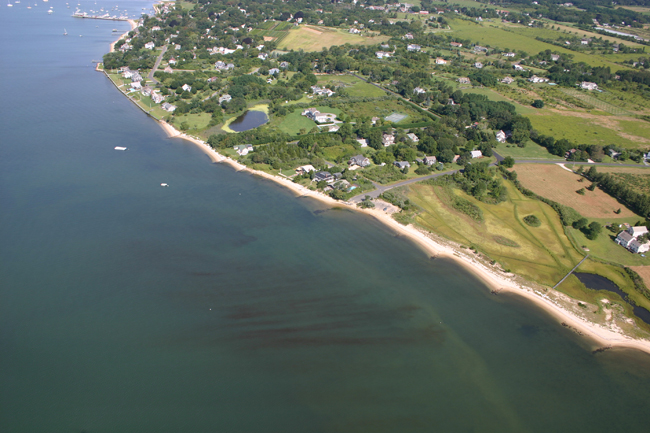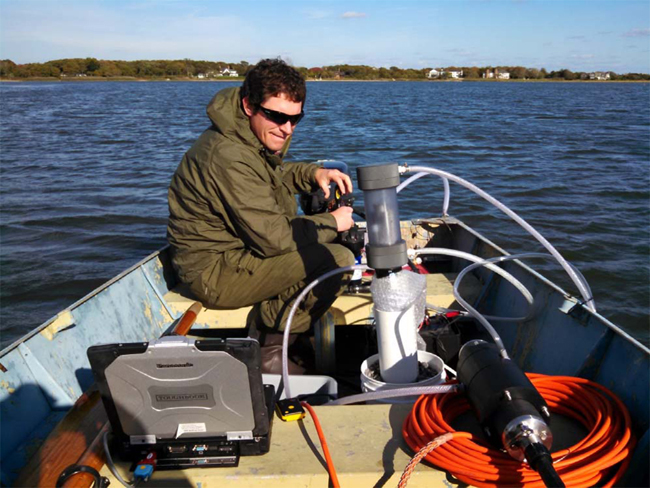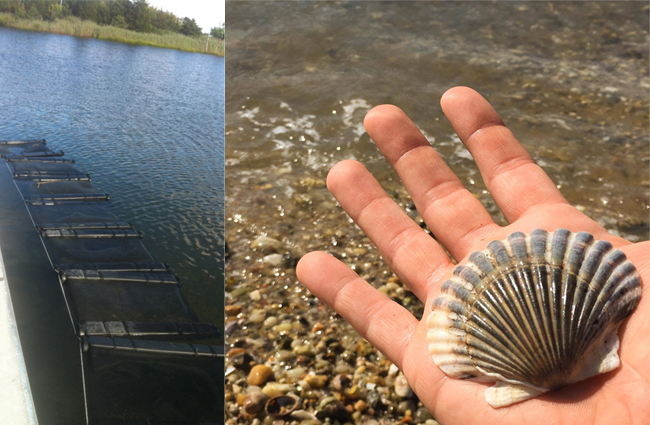
A harmful algal bloom (most likely from the alga Cochlodiniuma) caused this rust tide in Orient Harbor. Credit: Peconic Estuary Partnership.
—Chris Gonzales, Freelance Science Writer, New York Sea Grant
Stony Brook, NY, September 8, 2020 - Rust tides turn the water reddish-brown and lead to massive fish kills. The algae not only cloud the waters but also disrupt the livelihood of professional anglers, and sometimes create such unpleasant conditions that they keep beachgoers from the shores. Even so, the toxin produced by the algae is not harmful to humans, even if someone were to ingest an affected organism.
“Blooms of Cochlodinium, also known as rust tide, typically have been considered ‘ichthyotoxic’, or fish killing,” said Dr. Christopher Gobler, a marine ecologist at Stony Brook University’s (SBU) School of Marine and Atmospheric Sciences (SoMAS). “This project demonstrated that they are also highly lethal to shellfish.”
In the research project funded by New York Sea Grant (NYSG), scientists placed bivalves (clams, oysters, and scallops) in different natural settings during harmful algal blooms (HABs) to better understand bivalve coping and survival.
The details of their findings are especially interesting to shellfish farmers, but also to anyone who enjoys shellfish or a visit to the coast.
Under pressure
“While we saw scallops killed by rust tides in consecutive years during this project, we have now seen the same impacts on eastern oysters,” said Gobler. “The good news, however, is we also discovered that locating aquacultured shellfish at depth seems to allow them to survive even extremely dense rust tides.”
In experiments in natural settings during blooms, scallops deployed near the surface had an especially hard time surviving, with 75-100% mortality. Scallops deployed in deep water and clams and oysters either at the surface or at depth tended to survive better.
The younger oysters and scallops that survived had reduced growth rates, but clams and older scallops and oysters were unaffected.
All shellfish cultured near the surface were at greater risk of harm than those cultivated in deeper waters during C. polykrikoides blooms. These results, scientists say, should be noted by managers of aquaculture facilities.

A high-speed sampling apparatus is used for Cochlodinium surveys. Credit: Matt Harke.
What researchers did
Scientists placed shellfish in Shinnecock and Peconic Bays on Long Island, New York during bloom events related to the presence of C. polykrikoides.
Before they could place the shellfish in the water, though, scientists needed to monitor and detect a bloom.
They found that within the patches of water where blooms were present, C. polykrikoides represented more than 90% of microplankton.
Since they wanted to test age- and species-specific effects of the harmful algae they used one- and two-year-old shellfish of different species.
A paper on this topic was recently published in the scientific journal Estuaries and Coasts.(1)
Growing shellfish

(At left) Bags of clams, oysters and scallops are cultured off of a dock in East Creek, Long Island, New York. Credit: Andrew Griffith, NYSG Scholar; (At right) A scallop shell washed ashore in Long Island's Noyac Bay. Like other aquatic filter feeders (clams, oysters, mussels), scallops face survival challenges in bays, estuaries and other waters due to a number of water quality issues, including impacts from harmful algal blooms. Credit: Paul C. Focazio/NYSG.
These findings have implications for aquaculture managers. In short, blooms of C. polykrikoides can be harmful to shellfish of different ages and species in the Northern Hemisphere.
Scientists observed that during blooms, shellfish had a harder time growing and surviving.
Hard clams appeared resistant to blooms, and first-year oysters and scallops that survived blooms had stunted growth. In particular, first- and second-year bay scallops suffered significant declines in survivorship.
Overall, aquaculture installations near the surface may be at greatest risk.
Life cycle of harmful algae
In their life cycle, dinoflagellates like the one that causes rust tide produce cysts. Some observers have used the analogy of “seeds” to describe them: part of the zygotic stage of life, they are hard, at rest, and well-preserved, and are typically dispersed in sediments. In this phase, they can survive under unfavorable conditions, and initiate blooms.(2)
In this study, scientists developed a new method to quantify C. polykrikoides cysts in bays, harbors, and estuaries. This accomplishment is a scientific first.
Co-cultured with macroalgae
In another part of the study, researchers tested whether bivalves might benefit from being raised (cultured) together with macroalgae (Gracilaria spp. and Ulva spp.).
But co-culturing the bivalves with those two species of macroalgae didn’t afford the bivalves any protection.
New DNA study
C. polykrikoides is known for being distributed in inconsistent patches. Thus mapping the chlorophyll fluorescence—extracting the energy-producing cells from algae, georeferencing them to the exact point of collection, and studying their DNA fingerprints—can help scientists map the distribution of blooms.
Using DNA detection technology, they could test specifically for C. polykrikoides. Scientists called the successful test “probe P442.”
This work advances the state of progress in developing a chemical test for C. polykrikoides; this is the first study to develop such a test. This test could even detect mild blooms in new areas and that were previously undetected.
To keep the dinoflagellate out of their hatchery waters, scientists suggest that managers might benefit from using a 10-μm mesh sock on their water source intake to protect against C. polykrikoides blooms.
The researchers point out that scallop aquaculture in particular becomes more risky in times of C. polykrikoides blooms, compared to clam and oyster aquaculture.

(At left) A 2016 toxic ‘rust tide’ in the Peconic Estuary. Credit: courtesy of US Coast Guard Auxiliary; (At right) A 2008 red tide in Suffolk County's Flanders Bay. Credit: Suffolk County Department of Health Services.
References
(1) Griffith, A., Shumway, S., and Gobler, C. (2019) Differential Mortality of North Atlantic Bivalve Molluscs During Harmful Algal Blooms Caused by the Dinoflagellate, Cochlodinium (a.k.a. Margalefidinium) polykrikoides. Estuaries and Coasts 42:190–203
(2) Jung, S.W. et al. (2018). Mapping distribution of cysts of recent dinoflagellate and Cochlodinium polykrikoides using next-generation sequencing and morphological approaches in South Sea, Korea. Sci Rep 8, 7011 (2018).
More Info: New York Sea Grant
New York Sea Grant (NYSG), a cooperative program of Cornell University
and the State University of New York (SUNY), is one of 34 university-based
programs under the National Oceanic and Atmospheric Administration’s
National Sea Grant College Program.
Since 1971, NYSG has represented a statewide network of integrated
research, education and extension services promoting coastal community
economic vitality, environmental sustainability and citizen awareness
and understanding about the State’s marine and Great Lakes resources.
Through NYSG’s efforts, the combined talents of university scientists
and extension specialists help develop and transfer science-based
information to many coastal user groups—businesses and industries,
federal, state and local government decision-makers and agency managers,
educators, the media and the interested public.
The program maintains Great Lakes offices at Cornell University, University at Buffalo, SUNY Oswego and the Wayne County Cooperative Extension office
in Newark. In the State's marine waters, NYSG has offices at Stony Brook
University in Long Island, Brooklyn College and Cornell Cooperative
Extension in NYC and Kingston in the Hudson Valley.
For updates on Sea Grant activities: www.nyseagrant.org has RSS, Facebook, Twitter, Instagram, and YouTube links. NYSG offers a free e-list sign up via www.nyseagrant.org/nycoastlines for its flagship publication, NY Coastlines/Currents, which is published quarterly. Our program also produces an occasional e-newsletter,"NOAA Sea Grant's Social Media Review," via its blog, www.nyseagrant.org/blog.